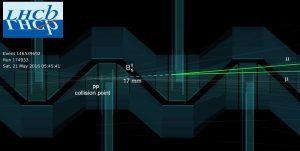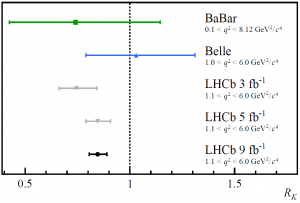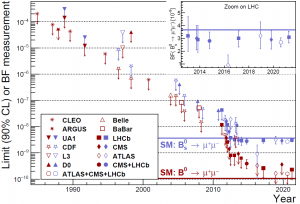 Today, at an important (virtual) conference held in Moriond, Fr, and at the CERN seminar, the LHCb collaboration presented two new results using the full LHCb Run 1 and Run 2 data set.
Today, at an important (virtual) conference held in Moriond, Fr, and at the CERN seminar, the LHCb collaboration presented two new results using the full LHCb Run 1 and Run 2 data set.
The first is an updated measurement of the ratio RK, an important test of a principle of the Standard Model (SM) of particle physics known as lepton universality, which states that the SM treats the three charged leptons (electrons, muons and taus) identically, except for differences due to their different masses. In the SM RK must be equal 1, while today result indicates evidence for the breaking of lepton universality in beauty-quark decays, with a statistical significance of 3.1 standard deviations. All RK measurements are shown in Figure 1: the previous LHCb ones are shown on the plot as grey points with error bar. The newly measured value of RK (black point with error bar) is consistent with and supersedes previous LHCb results.

The second result announced today is an improved measurement of the very rare Bs0→ μ+μ– decay. The probability, or branching fraction, of the Bs0 meson to decay into two oppositely charged muons is very small in the SM and is precisely calculated. On the other hand, a large class of theories that extend the SM, such as, for example, supersymmetry, allows significant modifications to this branching fraction and therefore an observation of any significant deviation from the SM prediction would reveal the influence of new physics. The measured branching fraction (3.09+0.46-0.43+0.15-0.11)x10-9 presented today is in agreement with the SM prediction of (3.66±0.14)x10-9. It is the most precise single experiment measurement to date.
 “The decay of a Bs0 meson into a muon pair has long been regarded as one of the most promising places to search for the effect of new physics”, says Barbara Sciascia team leader of the LHCb Frascati group. “This decay has been searched for more than 30 years by different experiments at different accelerators (see Figure 2). Since the beginning, the Frascati group actively participated to the search within LHCb, also thanks to the effort of many excellent undergraduate and graduate students who prepared their thesis taking part to the results obtained along the years, including the one announced today.”
“The decay of a Bs0 meson into a muon pair has long been regarded as one of the most promising places to search for the effect of new physics”, says Barbara Sciascia team leader of the LHCb Frascati group. “This decay has been searched for more than 30 years by different experiments at different accelerators (see Figure 2). Since the beginning, the Frascati group actively participated to the search within LHCb, also thanks to the effort of many excellent undergraduate and graduate students who prepared their thesis taking part to the results obtained along the years, including the one announced today.”
“Previous Bs0→ μ+μ– results already severely constrained New Physics models, yet within our precision there is still room for non-SM contributions, and several measurements actually seem to favour this option”, says Marco Santimaria, postdoc at the LNF and who presented the result at the today CERN seminar. “With today’s result we observed the Bs0→ μ+μ– signal with a statistical significance of 10 standard deviations, and with a branching fraction in good agreement with the SM prediction, strongly constraining any model of new physics.”
Currently the SM is the best description of the subatomic world. It has successfully explained almost all experimental results in particle physics and precisely predicted a wide variety of phenomena. However, it doesn’t explain aspects like the nature of the dark matter or the fate of the antimatter created at the big bang, and that is why LHC experiments are trying to find hints of new physics, which would solve some of these enigmas. All candidate models of physics beyond the SM including models which propose explanation of hints for lepton universality anomalies, like RK, the other LHCb result announced today, will have to demonstrate their compatibility with the strong constraint imposed by this new milestone in the study of the Bs0→ μ+μ– decay. Both theoreticians and experimentalists eagerly await the harvest of data expected from the forthcoming Run 3 of the LHC to shed light on the details of the physics beyond the SM.
Read more in the LHCb Moriond presentation, in the LHCb CERN seminar, in the LHCb papers, and in the LHCb public page for RK [https://lhcb-public.web.cern.ch/Welcome.html#RK2021] and Bs0→ μ+μ– [https://lhcb-public.web.cern.ch/Welcome.html#BsMuMU2021]
 INFN-LNF Laboratori Nazionali di Frascati
INFN-LNF Laboratori Nazionali di Frascati